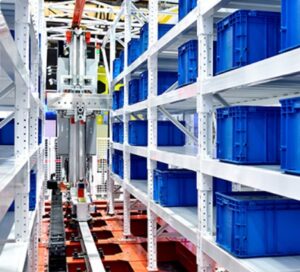How to Scale Up Manufacturing: Should I Scale or Should I Grow?
SOURCE: Plexus Blog
 With labor shortages and the boom in e-commerce expected to continue, the warehouse automation industry will continue to grow as well. And with a variety of new companies joining the industry, the need to keep up with demand while creating innovative products is more important than ever. For the long-term health of your business, you need to be smart about how you keep up with demand. If you invest too much too quickly, you could be in a difficult spot if demand levels off. If you’re not able to react quickly enough, you could miss the opportunity to capitalize. So, as you’re looking for ways to keep up with demand, you may be wondering if you should be looking to scale up manufacturing or grow your business.
With labor shortages and the boom in e-commerce expected to continue, the warehouse automation industry will continue to grow as well. And with a variety of new companies joining the industry, the need to keep up with demand while creating innovative products is more important than ever. For the long-term health of your business, you need to be smart about how you keep up with demand. If you invest too much too quickly, you could be in a difficult spot if demand levels off. If you’re not able to react quickly enough, you could miss the opportunity to capitalize. So, as you’re looking for ways to keep up with demand, you may be wondering if you should be looking to scale up manufacturing or grow your business.
While both options lead to increased profits and the ability to keep up with output and innovation, there is a keen distinction between growth and scale. According to the Harvard Business Review, when you grow your business, you are adding revenue at a similar rate to which you’re adding resources. Scaling your business also means you’re increasing revenue, but you’re adding resources at a slower pace. For both, outsourcing can be your answer — a partner to support you to meet demand at scale while allowing you to grow appropriately to reach it.
To help keep you out of limbo on which direction to take, we put together often-overlooked considerations you should make when looking to foster your innovative spirit and your customer’s demands. Making these considerations very early on in your product design phase is key to getting ahead of major roadblocks that’ll slow you down and cost you more in the long run:
Is my product design set up for easy manufacturability?
Innovative ideas drive companies, but there needs to be a healthy mix of innovation with manufacturable plausibility. Just about any product can be manufactured at low volumes when initial lead times can be longer and process flexibility is still an option. But, as demand grows, those areas of flexibility can evaporate quickly.
This step, above all others, impacts every part of your ability to increase output to meet demand. If this is your first product launch or you’ve had steady demand for a while, tunnel vision of the final product design might make issues a little hard to see. That’s why it’s important to get an outside view of your designs. This view can be completed by internal engineering and manufacturing team members working on other projects, or an outside firm that has expertise in designing products for manufacturability.
During the manufacturing-team deep dive, there are two key areas to explore: the assembly flow and the assembly handling. This process allows you to make decisions about how your manufacturing process and work cells need to be set up to work efficiently. And, you’ll get insight into where you can potentially work in automation resources so you’re ready to keep up with increased volumes.
When the engineering team looks into the design, they can provide a sanity check on the overall design. For instance, you’ll get information on if the parts are designed for the right fabrication processes that are needed to keep up with volume. They’ll also be able to give you guidance on material waste, secondary operations and inspection and control dimensions – all things that unintentionally drive fabrication costs. Additionally, if pieces aren’t lining up between the engineering and manufacturing teams, you’ll find out if redesigns are required.
If you already have your engineering and manufacturing teams working through the deep dive into the product, and you’ve budgeted time in for redesigns, you’re leaning toward the growth path. Outside partners can still help you in this process if you want a solid outside perspective, but it’s more beneficial if they’re involved in other processes. That way there can be smoother transitions from design to build.
However, if the timelines for getting the design right are tight, outside design support is a great way to work through issues in a more streamlined fashion. That option leans toward the scale path. And, when you’re looking for a partner in this area, you’ll want to make sure the company has extensive knowledge in design considerations that impact warehouse automation products.
Will my supply chain be able to keep up with my goals?
Whether you’re launching a new product or working through a product update, you need to have the right material suppliers in place. If you already have established suppliers, the path for their business may not match yours. Depending on what components you’re already purchasing from them, they may have a set capacity they can handle. It’s worthwhile to have a conversation with your suppliers to make sure that they can keep up with your increasing demand.
Any design changes that trigger the need for new parts should also be a topic for review with your material suppliers. You should check that they can get the parts you need, look at lead times and dig into their capacity planning abilities. If lead times are long from the start, it could hinder your ability to ramp up production at the speed that helps you reach your goals.
If you plan to take your product offering from regional to global, that should also be on the list to check with your suppliers. Again, if they don’t have the ability to provide a global offering, it’ll trigger a search for new material suppliers.
These conversations can give you a clear indication of whether you’re looking to scale or grow your business. If your existing suppliers can’t handle those needs, but you’re willing to take the time and devote resources to finding new suppliers to meet each of these needs, you’re likely on the growth route.
But, if the thought of finding new suppliers that help you meet your goals triggers some heartburn, the scale path may be a better fit. Instead of looking for a variety of new suppliers to meet each need, there are companies that offer supply chain services that can cover all of those needs. So instead of adding multiple resources, you’re adding just one.
Do I have enough team members to keep up with our projected demand without getting burnt out?
As demand increases, having the team in place to keep up might already be on your list of to-dos. But to manage the path to future success, you also need to keep your internal knowledge. The current state of labor shortages is no secret, but the reasoning for people leaving or staying in roles is changing significantly from where it’s been in the past. More and more, people are bucking “the grind” work practices of the past in favor of more work-life balance.
As companies ramp up their output, people often take on extra responsibilities, leading to burnout. With the added cost and time it takes to fill newly created roles, reaching your goals can be hindered if you’re also trying to fill knowledge gaps created by people leaving positions.
If you’re looking for business growth, you’ll need to make concessions on the workload of your existing team or establish longer timelines to accommodate getting any new hires up to speed. When you’re looking to scale your business, the number of open roles you create can be offset by using an outside partner for design, manufacturing and supply chain resources. The right partner will not only have experience in your industry to fill knowledge gaps but will be able to help you in all areas of product development so you can stay on your timelines.
Do I have the facilities available to keep up with the demand?
This consideration follows closely with the manufacturability of your product and is often the steepest investment that is required when a business increases output. If more space is needed, renting, purchasing or constructing a facility are often the first options that jump to mind.
Construction gives you the flexibility to build the perfect plant for your needs now and in the future. But, this option adds a significant timeline that is often not under your control. In today’s climate, the construction industry is seeing all-time highs in costs and lead times, which need to be weighed against the residual payments you’ll incur for maintenance and taxes on a new facility. That dynamic can make purchasing or renting a facility look attractive.
A ready-made building allows you to cut timelines and construction costs. But, the real estate market right now can be a tough nut to crack. Since you’ll need to find a space that allows flexibility for future projects outside of the goals you’re trying to achieve now, the limited options on the market can draw out this process.
There is a third option, and that’s outsourcing the manufacturing of your product. With buildings already in place to handle growth, and the expertise in manufacturing processes, you don’t need to divert attention or resources to get your manufacturing processes up and running.
But what does this all mean in the scale or growth decision path? If you are looking to own, or take ownership through the lease of a building, and you have the capital to make the investments in timelines and costs, you are firmly setting yourself in the growth direction.
When you’re looking to scale, outsourcing can save you the time and money required to get a facility up and running. You’ll not only get the benefit of having a ready-made building and a team with manufacturing expertise, but you’ll also be able to meet your goals while keeping your overhead low.












